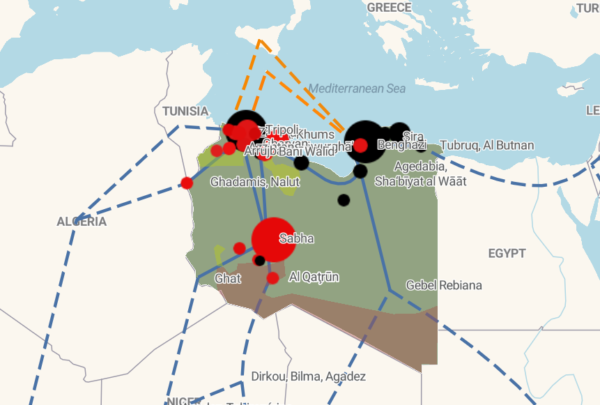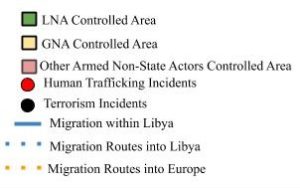
Mapping the Nexus between Human Trafficking and Terrorism in Libya
As a result of the coronavirus outbreak, the UN has announced it will suspend pivotal activities that protect the over 600,000 migrants from the violent and criminal activities that have run rampant in Libya for the past 9 years. Without the help of outside resources, Libyan migrants will be greatly exploited by traffickers and terrorist organizations operating in the region.
Background
Libya has devolved into a hub of violence and intersecting criminal economies since the 2011 NATO-backed overthrow of Colonel Muammar Gaddafi. The illicit trafficking of arms, drugs, and humans has flourished as the state descends into disarray. The internationally recognized Government of National Accord (GNA) lacks the resources to address the exploitation of Libya’s power vacuum by traffickers. The capacity they do have is funneled towards the conflict with the Libyan National Army (LNA). Mass migration coupled with the growth of terrorism in the region has further destabilized the situation, causing Libya’s neighbors to be involuntarily impacted by the conflict.
With the state ungoverned and an excess supply of unregulated weapons, terrorist groups such as ISIS have flocked to Libya and new extremist groups grew out of the conflict, making for an increasing number of violent players in this fractured state. Following the rise of terrorism in the state, the migration crisis came to a head in the summer of 2015. Floods of migrants from Niger, Chad, Egypt, and Sudan have traveled to Libya in hopes of escaping to Europe to be free of economic turmoil and escalating violence in their home countries. As a result, the lack of effective governance in Libya has increased the vulnerability of the population for traffickers and terrorists to prey on. Within a few years, Libya became a convenient nexus and transit point for illicit goods and terrorism, resulting in a threat that extends beyond the immediate region.
Map

This map utilizes news reports and the START Global Terrorism Database to estimate the incidents of human trafficking, terrorism, and the primary migration patterns, dating back to 2017. Larger dots represent a greater number of instances found in that city. The map visualizes the most popular destinations for human trafficking and terrorism in Libya. Incidents of human trafficking and/or terrorism encompass slave auctions, witness accounts, attacks/fatalities, and known recruitment areas.
The map suggests a correlation between migration patterns, human trafficking, and terrorism incidents. Coastal cities are used by traffickers to ship their victims to Europe for further exploitation. Those same cities have the largest populations, making them lucrative targets for terrorist organizations seeking to disrupt the public. With human traffickers and terrorists operating in the same area, it is imperative to address how these criminal operations may interact with each other and share in the benefit of forced labor.
The Nexus between Terrorism and Human Trafficking in Libya
Terrorism and human trafficking not only benefit from instability but also benefit from each other’s presence. Terrorist organizations create supply and demand for traffickers. While buying trafficked victims to provide services for their recruits, terrorist organizations simultaneously create vulnerable populations for traffickers to lure. Below are examples of how the nexus between terrorism and human trafficking benefits the perpetrators of such acts:
Using Human Trafficking to Attract and Gain New Recruits
- Sexual Slavery
- By purchasing women from traffickers, terrorist organizations tempt new male recruits by offering victims as sexual commodities and brides.
- Labor Trafficking
- Terrorist organizations attract new recruits by providing basic resources that the Libyan government has failed to offer, utilizing trafficked victims as a labor force for their support operations (cooks, porters, etc.). If they cannot tempt enough new recruits, they resort to using the trafficked victims in their place to expand military capabilities (combatants, spies, etc.).
Terrorism causing Human Trafficking
- Sexual Slavery
- Women were reported missing after escaping from Boko Haram. They traveled as fugitives from Southern Nigeria, through Niger and Libya, only to be recaptured by traffickers in Europe and forced into prostitution.
Terrorism Organizations Economically profiting from Human Trafficking
- Kidnapping and torturing to extort money from victim’s loved ones.
- In one year, ransom payments extracted by the Islamic State amounted to between $35million and $45 million.
- Taxing Traffickers in exchange for safe passage
- Armed terror groups control the Southern border of Libya, enabling them to exert authority over smugglers/traffickers and impose taxes at the entrance of the migrant routes into the state.
Taking a Stance Against Human Trafficking
Despite the trends, Libya has not criminalized labor trafficking and has criminalized only some forms of sex trafficking. Libya’s definition of sex trafficking requires there to be transnational movement and does not cover acts that were induced through fraudulent or coercive means, or acts involving adult male victims, who are not affected as much as women but still make a percentage of victims in Libya.
The operation of criminal economies undermines the legitimacy of the state, leading citizens to ignore the government as an authority. Criminal economies, therefore, feed security issues including terrorism. Efforts should be reoriented to stem the flow of migrants into Libya, not just Europe. By doing so, it will cut the supply of vulnerable populations that get into the hands of traffickers and terrorist organizations, placing peace further within Libya’s grasps.
In February 2017, Italy and Libya signed an EU-backed deal that would stem the flow of migrants, stipulating that Italy and the EU would support the Libyan coastguard and Tripoli would prevent migrants from leaving its borders. Since the deal, the EU has continued to funnel tens of millions of dollars to the UNHCR. In turn, the UNHCR and IOM (sister organization of UNHCR) have safeguarded this funding by providing training and equipment to the Libyan coastguard and monitoring the detention centers lining the shorelines of Libya. The current policy culminates into an ever-growing population vulnerable to criminal enterprises.
The US should take an active role in pressuring its EU partners to reconsider their current policy, prioritizing the flow of migrants into Libya. If the EU changes the direction of its policy, it will not only stem the flow of migrants into Europe but also work to slow the growth of terrorist organizations in the region who threaten US interests.






